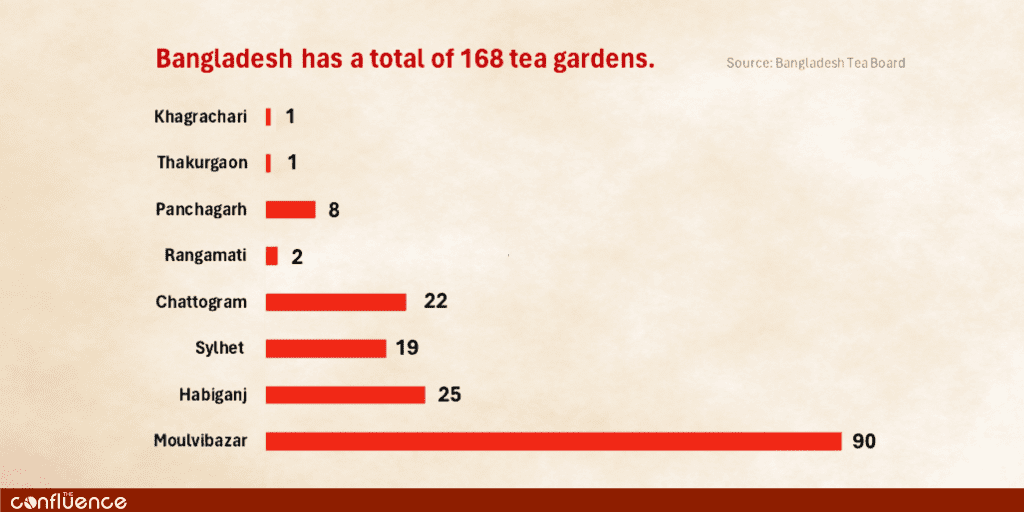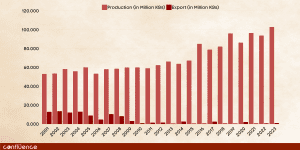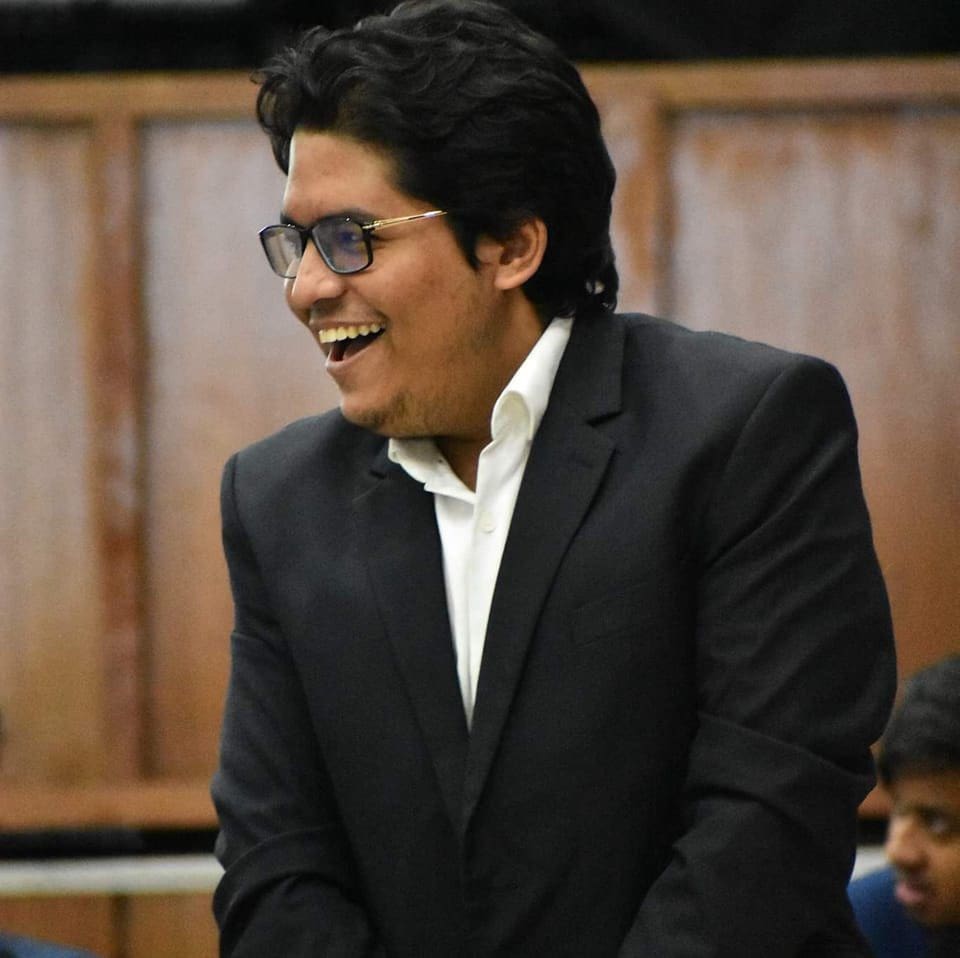In 2023, Bangladesh produced the highest number of teas in the country’s 180-year-long history of tea cultivation, generating a total of 102.92 million kilograms from 168 tea gardens across Bangladesh. However, Bangladesh, once one of the largest exporters of tea, has now become one of the biggest importers of tea because the domestic production of tea has failed to meet the surging local demand. After jute, tea is the second most significant cash crop in Bangladesh, with a contribution of around 1% to the overall GDP of the country. According to the London-based International Tea Committee, Bangladesh now ranks 8th in global tea production from the 10th position a decade ago, whereas a total of 47 nations cultivate tea, according to the Food and Agriculture Organization of the United Nations (FAO). This article looks at Bangladesh’s tea industry and how it can address some of the challenges of becoming a tea-exporting nation.
Early Days of Bangladesh’s Tea Industry
Bangladesh’s tea cultivation journey commenced in 1840, when the first tea farming started experimentally during British rule in the Pioneer Garden of Chattogram on the slopes of the hills, which is now the Chittagong Club. Mr. Sconce, who was the Chattogram Collector at the time, gathered tea seeds from Assam and Chinese saplings from the Botanical Garden of Calcutta. He cultivated these saplings and seeds in the Pioneer Garden, thereby establishing the Pioneer Tea Garden. During British rule, two attempts were made to cultivate tea in Chattogram (then Halda Valley) in 1828 and 1840. However, both attempts were proven futile. The first successful commercial tea cultivation started in 1854 at Malnicherra Tea Garden in Sylhet (then Surma Valley), which is near the present airport road of Sylhet.
Only two regions of then-East Pakistan, the Halda Valley, or Chattogram, and the Surma Valley, or Sylhet, produced tea before Bangladesh’s independence. Currently, 6 valleys divide the Surma Valley, also known as Greater Sylhet: Laskarpur Valley, Balisera Valley, Manu-Dalai Valley, Longla Valley, and North Sylhet Valley. Starting from 2002, tea cultivation was expanded to various regions of Bangladesh, including Panchagarh, Lalmonirhat, Thakurgaon, Nilphamari, Dinajpur, and Bandarban in the Chittagong Hill Tracts.
In 1947, during the partition of India and Pakistan, Bangladesh (then known as East Pakistan) possessed 103 tea estates, which spanned across 26,734 hectares of land dedicated to tea cultivation. These estates produced a total of 18.36 million kilograms of tea annually, with an average yield of approximately 639 kilograms per hectare. Domestic consumption amounted to approximately 13.64 million kilograms until 1955. Subsequently, there was a significant increase in home consumption, prompting the Government to enforce a compulsory annual expansion of the tea area by 3% in 1961. In 1970, the tea plantation area expanded to 42,658 hectares and the production increased to 31.38 million kilograms. During the liberation war in 1971, our tea industry experienced extensive destruction, leading to inadequate management, high levels of vacancies, insufficient resources, deteriorated factory machinery, and inadequate maintenance. Consequently, this resulted in decreased productivity and a decline in the quality of tea. In addition, global tea production has been steadily increasing at an annual rate of 3%. In Bangladesh, tea production has seen a growth of 1.84% and contributes 1.37% to the global tea trade, generating approximately 1775 million Taka (with an exchange rate of Taka 69 = USD 1.00) in annual revenue.
Bangabandhu’s Contribution
Bangabandhu Sheikh Mujibur Rahman was appointed as the first Bengali Chairman of the Tea Board from June 4, 1957, to October 23, 1958. Following are some of the major contributions of Bangabandhu in bolstering Bangladesh’s tea industry during his tenure as the chairman of the Tea Board as well as the Prime Minister of Bangladesh:
-
- Bangabandhu undertook critical initiatives to facilitate research for the burgeoning tea industry by setting up a laboratory and library at the Tea Research Station at Sreemangal in Moulvibazar.
- Bangabandhu amended the Tea Act, 1950, to establish the Contributory Provident Fund (CPF) for the officers and employees of the Tea Board. This provident fund is still operational and currently supports the human resources of the Tea Board.
- Throughout his term, he expedited the construction of the Tea Board’s main headquarters in Dhaka and enhanced the research endeavors of the Sreemangal Tea Research Station in Moulvibazar.
- Bangabandhu also played a crucial role in the development of high-yielding variants (clones) of tea plants. He initiated the planting of high-yielding saplings in the Karnaphuli tea gardens in Chattogram and Karanura in Sreemangal to guarantee a substantial tea harvest.
- Tea gardens incurred significant damage during the War of Independence in 1971. After gaining independence, Bangabandhu Sheikh Mujibur Rahman implemented several initiatives to revive the industry. One of these measures was the establishment of the “Bangladesh Tea Industries Management Committee (BTIMC)” to restore abandoned tea plantations that were left in ruins after the war. By 1975, plantation owners were given war-damaged abandoned plantations.
- Bangabandhu obtained loans from the “Industrial Development Bank of India” to reconstruct devastated tea factories and procure machinery for the tea industry.
- The government implemented cash subsidies and provided subsidized fertilizers to tea producers, and these measures are still ongoing.
- Bangabandhu prioritized the well-being of tea workers by offering them complimentary housing, access to clean water, facilities for infant care, primary education, and provisions.
- In 1973, he transformed the Bangladesh Tea Research Station into the Bangladesh Tea Research Institute (BTRI).
Overview of Tea Gardens
Over time, the industry expanded, and by 1970, there were 150 tea gardens, a number that has grown to 168 today as per the Bangladesh Tea Board. Besides, since 2002, small-scale tea plantations have been gaining popularity in Bangladesh, especially in Panchagarh, Lalmonirhat, Thakurgaon, Nilphamari, Dinajpur, and Bandarban districts. Bangladesh has 2 tea auction centers: Chittagong Tea Auction Center and Srimangal Auction Center. After the production of teas nationwide, teas are sold in bulk to buyers in these two auction centers.

Tea Production, Imports and Exports
While Bangladesh produced only 31.38 million kgs tea in 1970, the number now stands at 102.92 million kgs in 2023. According to the Bangladesh Tea Board, from January to March 2024, Bangladesh has produced around 1.75 million kgs tea, and exported around 0.70 million kgs (up to April), which enabled the country to earn 104.59 million BDT. In 2008, Bangladesh earned the highest amount through tea exports, which was 976.95 million BDT. In 2023, Bangladesh earned only 272.52 million BDT from tea exports.

In the past, the export of tea played a significant role in generating foreign currency for Bangladesh. Nevertheless, the surge in domestic consumption, which hit an all-time high of 9.65 crore kg in 2021, has put pressure on production capacities, resulting in decreased exports and heightened imports. According to the Tea Board of Bangladesh, tea exports from Bangladesh are gradually declining. Bangladesh exported only 0.68 million kg of tea in 2021, whereas tea exports were 2.17 million kg in 2020. Thus, ensuring the country exports more tea remains a crucial challenge to diversify Bangladesh’s export basket.
At present, Bangladesh exports tea to Australia, Bahrain, Brunei, China, Canada, Cyprus, France, Greece, India, Italy, Japan, Kuwait, Malaysia, Mauritius, New Zealand, Pakistan, Qatar, Saudia Arabia, the Solomon Islands, Switzerland, the UAE, the UK, and the US.
Support from the Government of Bangladesh
The Government of Bangladesh (GoB) has undertaken various initiatives to support the country’s tea industry. Following are some of the key initiatives that are transforming Bangladesh’s tea industry:
1. Tea Cultivation in Plain Land
The Awami-League government, under the leadership of Prime Minister Sheikh Hasina, took the initiative to start tea cultivation on plain land in the northern parts of Bangladesh in 1996. In this way, the government facilitated the utilization of unused and idle plain land, which cannot be otherwise used for other agricultural activities. Thus, tea cultivation on plain land contributes significantly to the overall tea production of the country, meeting both local and foreign demand. Currently, around 8,000 small growers are farming tea in the northern regions of Bangladesh. In 2021, about 14.54 million kg of tea were produced from plain land tea cultivation.
2. Small Tea Cultivation Project
The Bangladesh Tea Board has successfully executed numerous development projects using its allocated funds to enhance the growth and progress of the small-scale tea industry. The Ministry of Commerce approved the “Small Tea Cultivation Project” for the northern region, which aimed to cultivate 3000 hectares of land. The project was implemented from January 2001 to December 2006, with funding from the Bangladesh Tea Board and the Rajshahi Krishi Unnayan Bank. The project’s duration was prolonged until December 2009 by amalgamating additional districts in the northern region with Panchagarh.
The project’s duration was subsequently extended until 2014. The “Extension of Small Tea Cultivation in Bangladesh” is a notable initiative aimed at expanding small-scale tea cultivation in the northern region of Bangladesh. This project falls under the jurisdiction of the Ministry of Commerce and is being financed through the Official Development Assistance (ODA) and the EC Revolving Fund, with a total cost of Tk 74 million (7.40 crore). The project is being executed in a combined total of 16 upazilas within the region.
The Bangladesh Tea Board has successfully achieved the target of this project. The objective of the project was to cultivate 500 hectares of land for small tea plantations by 2021 in the region. It aimed to offer technical assistance to registered tea farmers and introduce innovative methods developed by BTRI. Additionally, the project sought to introduce high-quality BT series tea varieties to small-scale farmers, distribute affordable fresh cuttings and saplings, and contribute to social and economic development by creating employment opportunities in the project area.
3. Northern Bangladesh Project
The Northern Bangladesh Project is currently engaged in the production of 1.0 million BT series tea seedlings that are both high-yielding and high-quality. The objective is to distribute these seedlings at a low cost to the registered small tea growers in the region.
- Already, 883 thousand tea seedlings have been distributed among farmers at a reduced price as part of the program. In addition, a total of 400 pruning knives and 130 spray machines have been provided to registered small tea growers without charge.
- A training facility has been established at the regional office of the Bangladesh Tea Board in Panchagarh. Its purpose is to offer practical training to small-scale tea farmers.
- The Bangladesh Tea Research Institute (BTRI) has organized two-day annual training courses on cultivation specifically for tea plantations and small tea growers in the northern region. A total of 288 training workshops have been conducted, covering a wide range of topics related to tea cultivation, including planting, tipping, plucking, pruning, fertilizer application, pest and disease control, tea processing, and tea tasting.
- The Bangladesh Tea Board in Panchagarh has undertaken 1,580 field visits to tea plantations and small tea plantations in the area in order to offer essential guidance.
- The Project Development Unit of the Bangladesh Tea Board and Rajshahi Krishi Unnayan Bank have offered registered small tea farmers in Panchagarh free irrigation machinery, subsidies on tea seedlings, and loans with favorable conditions.
- A cumulative subsidy of Tk 949,000 was given to small tea farmers until 2009, amounting to Tk 1.0 per seedling, in order to promote tea cultivation. The Rajshahi Krishi Unnayan Bank provided a loan of Tk 12.5 million (1.25 lakh) to tea farmers in Panchagarh, based on the recommendation of the Bangladesh Tea Board, to support the expansion of tea cultivation until 2009.
4. Camellia Open Sky School
The Camellia Open Sky School provides practical training to small tea growers in the management of tea plantations in an outdoor setting. The purpose of this school is to provide systematic training to tea growers on cultivation techniques. The Bangladesh Tea Board’s Director of the “Extension of Small Holding Tea Cultivation in Northern Bangladesh” project, Dr. Md. Shamim Al Mamun, received instructions for the union-level implementation of the Camelia Open Sky School. The Camelia Open Sky School commenced its operations on October 25, 2020, aiming to deliver training services to tea growers in Tetulia Upazila of Panchagarh district. The Camelia Open Sky School has commenced operations in the Thakurgaon, Lalmonirhat, Nilphamari, Dinajpur, and Chattogram Hill Tracts (Bandarban, Rangamati, and Khagrachari), as well as in greater Mymensingh. A total of 32 practical training workshops have been organized under this program.
5. Roadmap: Bangladesh Tea Industry
On January 8, 2017, the Government of Bangladesh approved the “Roadmap: Bangladesh Tea Industry” to not only satiate the increasing domestic demand but also expand the export market for Bangladeshi tea by increasing the production of quality tea and improving the living standards of tea workers. The 11 programs on the roadmap will be implemented over the course of three terms: short-term (2016-2022), medium-term (2016-2025), and long-term (2016-2030). The government has already successfully implemented the short-term plan. As per the roadmap, the country has set a target to produce 140 million kg of tea by 2025. To attain the target, the Bangladesh Tea Board (BTB), under the Ministry of Commerce, has undertaken the following actions:
- BTB has developed 23 high yielding clones.
- BTB has provided fertilizer at a subsidized rate to the tea gardens and small tea growers.
- BTB has introduced a cash incentive of 4% for tea exporters.
- BTB is going to launch the ‘Tea Tasting and Quality Control Course’ in order to facilitate quality tea production in the country.
- BTB has established 7600 labor houses, 7600 sanitary latrines, 10 day care centers, and 26 mother clubs in order to cater to the welfare of tea workers.
- BTB has also introduced a new tea brand, namely ‘Bangladesh Tea’.
Other 2 notable projects that are currently operational under the BTB are: Extension of Small Holding Tea Cultivation in Chattogram Hill Tracts; and Eradication of Rural Poverty by Extension of Small Holding Tea Cultivation in Lalmonirhat.
In the second part of this series, I will discuss in detail what are the bottlenecks the tea industry of Bangladesh currently experiencing, and what should be done to rise above all the challenges.
About the Author

Shah Adaan Uzzaman is the Blog Administrator at The Confluence, and the Co-Founder & CEO of Dumpy. A former Bangladesh Television Debate Champion and winner of several policy & debate competitions, he is currently a student of IBA, University of Dhaka.